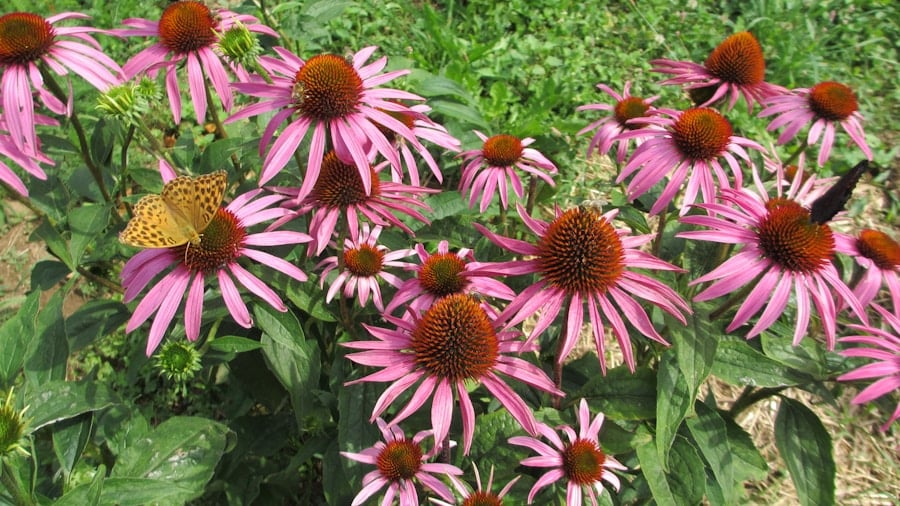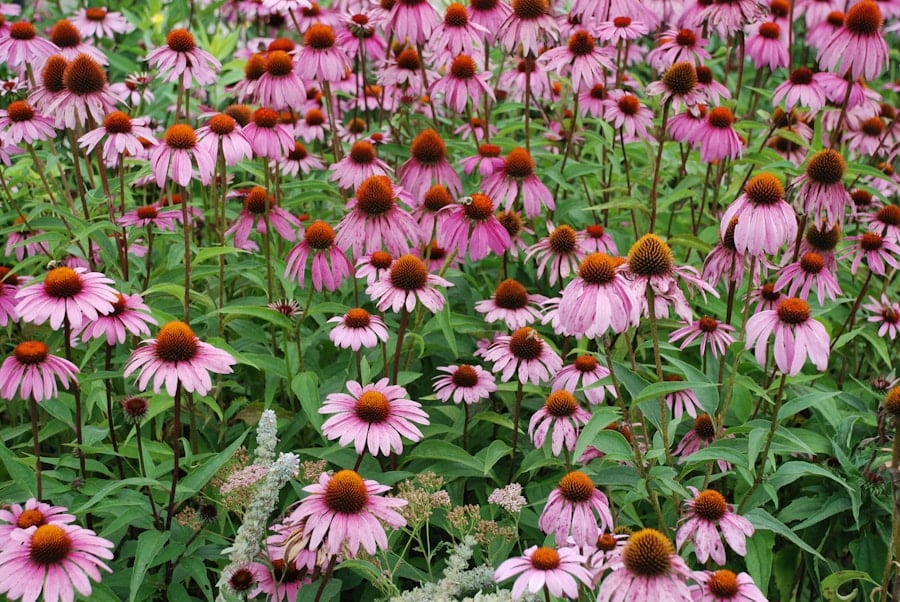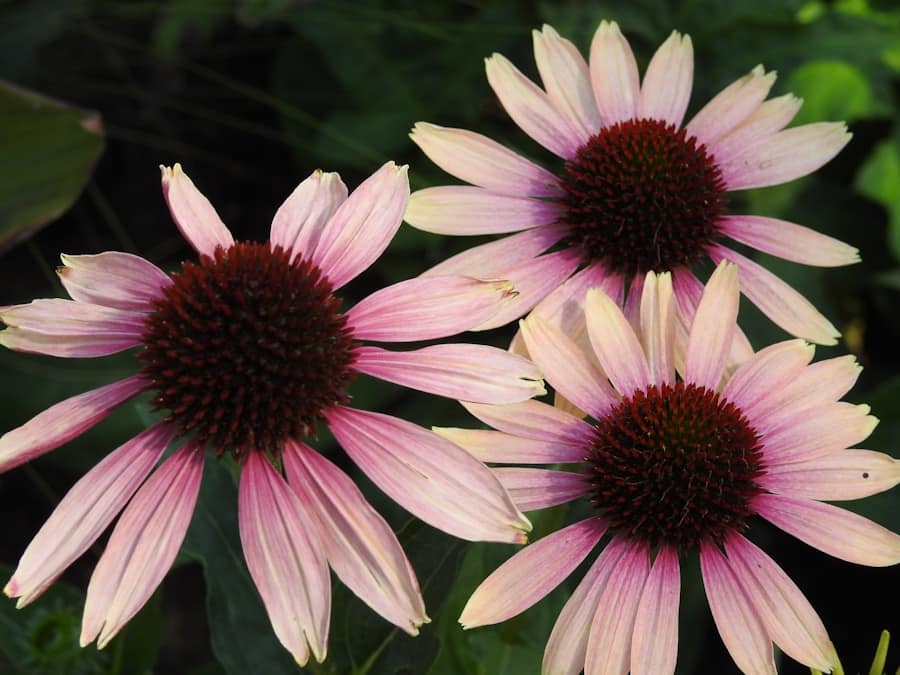When it comes to transplanting coneflowers, timing is everything. I’ve learned that the best time to move these vibrant perennials is during the early spring or early fall. In spring, as the soil begins to warm and the threat of frost diminishes, coneflowers are just waking up from their winter dormancy.
This is an ideal time because the plants are still in a relatively low-stress state, allowing them to adapt more easily to their new environment. Similarly, early fall presents another excellent opportunity. The cooler temperatures and increased rainfall help reduce transplant shock, giving the plants a chance to establish their roots before winter sets in.
I’ve also discovered that avoiding the peak of summer is crucial. During this time, coneflowers are in full bloom and actively growing, which makes them more susceptible to stress when uprooted.
By choosing the right time, I can ensure that my coneflowers have the best chance of thriving in their new location. Visit Our Site for more information about our products.
Key Takeaways
- The best time to transplant coneflowers is in the early spring or late fall when the weather is cool and the plants are dormant.
- Prepare the new location by ensuring well-draining soil and full sunlight to promote healthy growth.
- When digging up coneflowers, make sure to take a large root ball and handle the plant carefully to minimize transplant shock.
- After transplanting, water the coneflowers regularly and provide some shade to protect them from the sun until they are established.
- Monitor the transplanted coneflowers for signs of stress and address any issues promptly to ensure successful growth.
Preparing the Soil and Location for Transplanting Coneflowers
Preparation is key when it comes to transplanting coneflowers. I always start by selecting a location that receives full sun for at least six hours a day. Coneflowers thrive in bright light, and I’ve found that they produce the most vibrant blooms when they are well-situated in sunny spots.
Additionally, I make sure that the soil is well-draining, as coneflowers do not like to sit in waterlogged conditions. To achieve this, I often amend the soil with organic matter such as compost or well-rotted manure, which not only improves drainage but also enriches the soil with nutrients. Once I’ve chosen the right spot and prepared the soil, I take the time to clear away any weeds or debris that could compete with my coneflowers for nutrients and water.
This step is crucial because it helps create a clean slate for my plants to thrive. I also like to test the soil pH, aiming for a range between 6.0 and 7.0, which is ideal for coneflowers. If necessary, I’ll adjust the pH using lime or sulfur to ensure optimal growing conditions.
How to Properly Dig Up and Transplant Coneflowers

When it’s time to dig up my coneflowers, I approach the task with care and precision. I start by watering the plants a day before transplanting; this helps to hydrate them and makes it easier to remove them from the ground. Using a spade or garden fork, I gently loosen the soil around the base of the plant, being careful not to damage the roots.
I’ve learned that starting about six inches away from the plant’s stem allows me to lift it out with minimal disturbance to its root system. Once I’ve successfully dug up the coneflower, I inspect the roots for any signs of disease or rot. If I notice any unhealthy roots, I trim them away with clean shears to promote better growth in their new location.
Afterward, I place the plant in a container filled with moist soil while I prepare its new home. This step helps keep the roots hydrated and reduces stress during the transition.
Ensuring Proper Watering and Care After Transplanting Coneflowers
| Week After Transplanting | Watering Frequency | Soil Moisture Level | Additional Care |
|---|---|---|---|
| 1 | Every other day | Keep soil consistently moist | Apply organic mulch to retain moisture |
| 2 | Twice a week | Allow top inch of soil to dry between watering | Remove any weeds around the plants |
| 3 | Once a week | Keep soil evenly moist | Apply balanced fertilizer |
After transplanting my coneflowers, I make it a priority to provide them with adequate water. Initially, I give them a deep watering to help settle the soil around their roots and eliminate any air pockets that may have formed during planting. It’s essential to keep an eye on moisture levels in the following weeks; while coneflowers are drought-tolerant once established, they need consistent moisture during their initial recovery period.
I often check the soil regularly and water whenever it feels dry an inch below the surface. In addition to watering, I also pay attention to other aspects of care after transplanting. Fertilizing is another important consideration; I typically wait a few weeks before applying a balanced fertilizer to avoid overwhelming the plants.
Instead, I focus on mulching around the base of each coneflower with organic material like shredded bark or straw. This not only helps retain moisture but also suppresses weeds and adds nutrients back into the soil as it breaks down.
Addressing Common Issues and Challenges When Transplanting Coneflowers
Transplanting coneflowers can come with its fair share of challenges, and I’ve encountered several along my gardening journey. One common issue is transplant shock, which can manifest as wilting or yellowing leaves after moving the plant.
Additionally, providing shade for a few days after transplanting can help ease their transition into a new environment. Another challenge I often face is pests or diseases that may affect my coneflowers post-transplant. Aphids and spider mites are notorious for targeting these plants, especially when they’re stressed from relocation.
To combat this, I regularly inspect my plants for any signs of infestation and take action promptly if needed. Using insecticidal soap or introducing beneficial insects like ladybugs has proven effective in keeping pests at bay.
Tips for Transplanting Coneflowers in Different Climates and Regions

Timing is Everything
In warmer climates, I transplant coneflowers in early spring to avoid extreme heat during establishment. In contrast, in cooler regions, fall transplanting can be beneficial as it allows coneflowers to establish themselves before winter dormancy.
Soil Conditions Matter
Understanding local soil conditions is crucial for successful transplantation. For instance, in sandy soils, I incorporate organic matter to enhance moisture retention. In clay-heavy areas, I prioritize proper drainage to prevent waterlogged soil.
Regional Adaptation is Key
By tailoring my methods to regional characteristics, I can increase my chances of growing healthy and vibrant coneflowers. This adaptable approach has been essential for my success in transplanting coneflowers.
Transplanting Coneflowers for Maximum Bloom and Growth
To achieve maximum bloom and growth after transplanting my coneflowers, I’ve learned that spacing is crucial. Providing adequate space between each plant allows for proper air circulation and sunlight exposure, which ultimately leads to healthier growth and more abundant flowers. Typically, I space my coneflowers about 18 to 24 inches apart; this distance gives them room to spread without overcrowding.
Additionally, deadheading spent blooms throughout the growing season has become a regular practice for me. By removing faded flowers, I encourage my coneflowers to redirect their energy toward producing new blooms rather than setting seeds. This simple act not only prolongs their flowering period but also enhances their overall appearance in my garden.
The Importance of Patience and Monitoring After Transplanting Coneflowers
Finally, one of the most important lessons I’ve learned about transplanting coneflowers is the value of patience and ongoing monitoring. After moving these plants, it’s easy to become anxious about their progress; however, I remind myself that they need time to adjust to their new surroundings fully. Regularly checking on their health allows me to catch any potential issues early on while also giving me an opportunity to appreciate their gradual growth.
I’ve found that keeping a gardening journal helps me track my coneflowers’ progress over time. Documenting changes in their appearance or any challenges faced allows me to reflect on what works best for future transplants. Ultimately, patience combined with attentive care has proven essential in nurturing my coneflowers into thriving plants that bring joy and beauty to my garden year after year.
If you are considering transplanting coneflowers in your garden, you may also be interested in learning about the beauty and care of freesias. These vibrant perennials require specific care to thrive, much like coneflowers. To read more about how to care for freesias, check out this article.
FAQs
What are coneflowers?
Coneflowers, also known as Echinacea, are a popular perennial flower known for their daisy-like blooms and ability to attract pollinators to the garden.
When is the best time to transplant coneflowers?
The best time to transplant coneflowers is in the early spring or early fall, when the weather is cooler and the plants are not actively blooming.
How do I transplant coneflowers?
To transplant coneflowers, dig up the entire plant, including as much of the root ball as possible, and replant it in a new location with well-draining soil. Water the transplanted coneflowers thoroughly after planting.
Can I divide coneflowers when transplanting?
Yes, coneflowers can be divided when transplanting. Use a sharp knife or shovel to carefully divide the plant into smaller sections, making sure each section has both roots and foliage.
What are the signs that coneflowers need to be transplanted?
Signs that coneflowers may need to be transplanted include overcrowding, declining blooms, or poor soil quality in their current location.
Can coneflowers be transplanted while they are blooming?
It is not recommended to transplant coneflowers while they are actively blooming, as this can cause stress to the plant. It is best to wait until the blooming period has finished.

